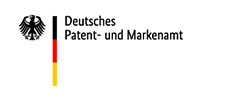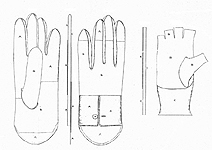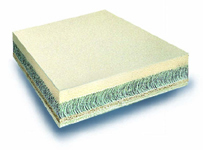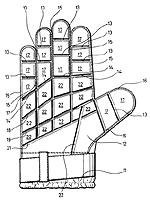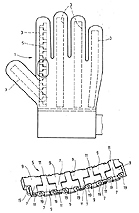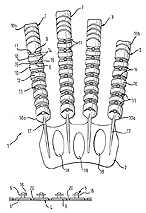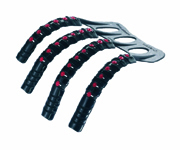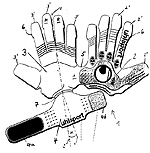Goalkeeper kit
2. Goalkeeper gloves
At the beginning of the 1970s it was rather unusual for a goalkeeper to wear gloves. However, this does not mean that the advantages of gloves have not been recognised very early.
2.1 Properties required of goalkeeper gloves
William Sykes, a British manufacturer of footballs, was granted a patent for a pair of leather gloves for a goalkeeper as early as in 1885. The gloves had a layer of india rubber for protection and cushioning purposes (GB 1885-7346 A, Figure 2).
The improvements of goalkeeper gloves focused not only on the protection but also on providing a better grip on the ball. In the 1980s, a large variety of different materials were attached to the inner (palm) side of the gloves, eg. terry cloths or the coating of ping pong paddles (Figure 3).
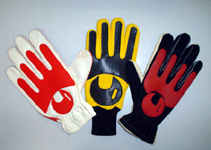
![]() Figure 3: Goalkeeper glove with terry cloths and coating of ping pong paddles (copyright Uhlsport GmbH)
Figure 3: Goalkeeper glove with terry cloths and coating of ping pong paddles (copyright Uhlsport GmbH)
Up to the present, the most diverse combinations of materials have been used to optimise grip, oa. synthetic materials with sticky effect attached to the inner (palm) side of the goalkeeper gloves (DE 195 30 282 A1).
Recent developments include a goalkeeper glove with improved gripping ability in wet conditions (US 2009/0 139 010 A1).
| Publication number | Year | Title | Brief description |
|---|---|---|---|
| DE 195 30 282 A1 | 1995 | Bekleidung, insbesondere Sportbekleidung, ganz besonders Torwartbekleidung | Goalkeeper glove with a sticky synthetic material on the inner (palm) side to provide better grip |
| GB 1885-7346 A | 1885 | Improvements in or relating to Gloves or Gauntlets Used in Football Playing | Goalkeeper gloves made of leather with layers or strips of india rubber |
2.2 Cushioning
Padding materials cushion a ball's impact and protect the hand of the goalkeeper during the game. The thicker the padding, the bigger the size of the glove compared to the hand. At the same time, the anatomy of the hand has to be taken into account so that the natural movement of the hand while grabbing and catching the ball is not compromised. Finally, all these features constantly increased the complexity of production.
For padding the palm, a variety of absorber materials are used, for example, three-dimensional fabric structures (so-called spacer fabric) directly inserted beneath the customary palm padding layer (DE 196 23 928 C2, Figure 4).
Other absorbers are provided for the edge of the hand. DE 196 11 335 C2 shows, for example, the cushioning of the outer edges of the hand, thus increasing the effective hand size. This means that the "work tool" of the goalkeeper will be expanded if suitably sturdy padding is used. This improves the keeper's chances of catching the ball.
| Publication number | Year | Title | Brief description |
|---|---|---|---|
| DE 196 23 928 C2 | 1996 | Sporthandschuh, insbesondere Torwarthandschuh | Goalkeeper glove with spacer fabric inserted in the palm beneath the customary padding material |
| DE 196 11 335 C2 | 1996 | Sporthandschuh, insbesondere Torwarthandschuh | Padding of a goalkeeper glove on the edge of the hand, resulting in a bigger effective palm size |
2.3 Segmentation
The increase in the extent of padding results in reduced flexibility of the fingers and the palm. This drawback must be counteracted by means of suitable segmentation of the palm of the glove, or cuts and embossments in the cover layers of the glove.
For example, DE 31 35 756 A1 describes a goalkeeping glove with strip-like foam thinned out at the knuckles of the inner (palm) side of the glove. This allows the fingers to flex forward normally. A similar principle is shown in
DE-GM 82 25 343. It describes a glove with predetermined buckling lines in the cover layer of the glove palm, in all areas relevant for bending the hand, in order not to hinder the movements of the hand (Figure 5).
Better flexibility can also be achieved by cuts in the cover layer of the palm of the glove without essentially weakening the padding. An example is shown in DE 297 19 08 U1. Here the cut is guided directly along the ball of the finger.
| Publication number | Year | Title | Brief description |
|---|---|---|---|
| DE 297 19 087 U1 | 1997 | Faltenfreier Torwarthandschuh für leichtere Handhabung des Balls | A cut near the ball of the finger enables natural movement of hand in a goalkeeper glove |
| DE-GM 82 25 343 | 1982 | Sporthandschuh für Ballspiele | Goalkeeper glove with predetermined buckling lines in the cover layer of the glove palm to enable natural movement of the hand |
| DE 31 35 756 A1 | 1981 | Torwarthandschuh | Goalkeeper glove oa. with strip-like foam thinned out at the knuckles of the inner (palm) side of the glove to enable near-natural use of hand |
2.4 Application of additional protection systems
Protection of the hand by additional protection systems is the most innovative field of research at present. These protectors prevent the fingers from bending backwards, against the natural direction of movement. Essentially, the protective effect is achieved by reinforcements inserted at the back of the glove's fingers. However, some protector straps are made of a not very extensible material and inserted in the lining of the palm of the glove (FR 2 882 898 A1). As DE 35 16 545 C2 shows, it has been common to insert protectors since the 1980s. This patent document describes indented reinforcement spines on the back of the glove's fingers and "webs" between the individual fingers intended to prevent lateral hyperextension of the fingers. EP 1 487 289 B1 shows an appropriate example that was apparently inspired by baseball.
Finger protectors may also have the form of blocking bodies fixed to a tension-resistant support strip, sewn in the foam cover of the glove, separately, for each individual finger (DE 199 10 799 C1). Other improvements show a link chain (DE 200 23 139 U1) or a system that protects the fingers from bending backwards made of T-shaped links (DE 103 29 796 B3, Figure 6) alternately interconnected by swivel elements. Another type of protectors are reinforcement elements with anchor-shaped rotational conntection (DE 20 2004 009 251 U1) whose length can be varied, as required, by interchangeable links.
DE 200 11 652 U1 describes a five-finger one-piece sewn-in plate with embossed grooves, filling out the entire back of the glove. The finger protector according to DE 20 2004 013 835 U1 (Figure 7) also applies to several fingers at once.
This protector gives the overall impression of claws. It is a plate with four separate finger protectors consisting of individual members which are connected in one piece with each other and correspond to the natural curvature of the hand. The whole protector is merely inserted into a pocket, integrated in the back portion of the glove and designed for this purpose. This enables an exchange of the protector at any time and allows the goalkeeper to customise it fast and without difficulties to his individual needs. Figure 8 shows what this protector looks like in reality.
Multi-component injection moulding allows to simultaneously process different plastic materials with different properties in one production step. So protector elements featuring specific local functionalities can be made of several plastic materials as a single piece, ready for use - that means without subsequent indentations or separate links. As shown in DE 10 2005 014 470 B3, the necessary flexibility and protective function is provided by the outer form and composition of the material of the protector rather than by its purely mechanical properties.
The thumb is the only finger of the hand that has a relatively high lateral flexibility and can rotate within a wide radius. Higher flexibility of the thumb is usually not sufficiently taken into account by conventional protector elements causing the protectors to slip and resulting in a reduction of the effectiveness of protection. DE 10 2004 043 779 A1 provides for a protector strip for a goalkeeper glove adjusted to the special anatomy of the thumb. This is achieved by a broadened protector section mimicking the shape of the joint at the base of the thumb.
FR 2 882 898 A1 goes the opposite way. Between the inner and outer lining of the glove, a strap with low elongation under traction is inserted, which acts from the palm to avoid hyperextension of the fingers.
Gloves with crumple zones or additional finger caps provide other methods to protect the hand of the goalkeeper (EP 2 113 291 A1). In case of the crumple zone of US 2008/0 109 935 A1, a tape-like finger extension (32) is attached, which extends over the fingertip and is fastened to both sides of the glove finger. The forces of a frontal impact acting on the tip of the finger from outside are considerably absorbed and to a great extent dissipated away from the fingertip and directed along the attachment legs along the length of the lateral areas of the glove finger (Figure 9). The extension also enlarges the effective surface area of the hand, possibly offering an additional advantage to the goalkeeper when catching the ball, provided it is not perceived as a foreign body.
| Publication number | Year | Title | Brief description |
|---|---|---|---|
| US 2008/0 109 935 A1 | 2006 | Goalkeeper's glove with protective fingertip extension | Goalkeeper's glove with crumple zone at the fingertips |
| FR 2 882 898 A1 | 2005 | Gant comportant des moyens pour éviter le retournement des doigts | Goalkeeper glove with straps acting from the palm to avoid hyperextension of the fingers |
| DE 10 2005 014 470 B3 | 2005 | Glove reinforcing element | Finger protector for a goalkeeper glove manufactured in a single piece by multi-component injection moulding of plastic materials with the option to attach additional weights to the fingertips |
| DE 20 2004 013 835 U1 | 2004 | Fingerprotektor und damit ausgerüsteter Sporthandschuh | Finger protection for goalkeeper gloves (claws), consisting of a plate with four ray-type strips, consisting of individual members snapped together and forming the natural curvature of the fingers |
| DE 10 2004 043 779 A1 | 2004 | Versteifungsstreifen ausgebildet und bestimmt für einen Daumenbereich eines Handschuhs, insbesondere Torwarthandschuhs | Thumb protection element for a goalkeeper glove comprising a broadened section at the base of the thumb |
| DE 20 2004 009 251 U1 | 2004 | Versteifungseinrichtung für einen Handschuh, insbesondere Torwarthandschuh | Multi-link finger protector made of single elements with rotational connection |
| EP 1 487 289 B1 | 2003 | Soccer goalkeeper glove | Webbed goalkeeper glove, inspired by baseball |
| DE 103 29 796 B3 | 2003 | Protektorelement für orthopädische Anwendungen sowie für Sportbekleidungsstücke | Protection for goalkeeper gloves against bending fingers backwards consisting of T-shaped links alternately interconnected by swivel elements |
| DE 200 23 139 U1 | 2000 | Torwarthandschuh | Link chain as finger protection system for goalkeeper gloves, adjusted and sewn in separately for each finger |
| DE 200 11 652 U1 | 2000 | Sporthandschuh | Goalkeeper glove with five-finger one-piece protector against bending fingers backwards sewn in the back of the glove |
| DE 199 10 799 C1 | 1999 | Sporthandschuh, insbesondere Torwarthandschuh | Goalkeeper glove with reinforcing elements fixed to a tension-resistant support strip at the back of the fingers |
| DE 35 16 545 C2 | 1985 | Handschuh, insbesondere Torwarthandschuh | Protectors for goalkeeper glove made of indented reinforcement spines on the back of the glove's fingers and "webs" between certain fingers to avoid hyperextension of the hand or fingers |
2.5 Abrasion and cut pattern
The materials used for the palm of the glove must be very durable since certain pitch conditions may cause increased abrasion. This problem is compensated by adding materials to the surface layer material of the palm which have good abrasion resistance, but, owing to their geometry, elasticity and size, will not affect the glove's function (DE 298 00 073 U1). Such additives may be plastic granulate or synthetic fibres.
In order not to waste too much of the specialised material when manufacturing gloves, optimised cut patterns are used in production. A typical example is shown in DE 103 27 051 A1 (Figure 10).
| Publication number | Year | Title | Brief description |
|---|---|---|---|
| DE 103 27 051 A1 | 2003 | Sporthandschuh | Cut pattern for goalkeeper gloves |
| DE 298 00 073 U1 | 1998 | Sporthandschuh, insbesondere Torwarthandschuh | Goalkeeper glove with additives in the surface layer material of the palm to increase durability |
2.6 Weight balancing

![]() Figure 11: Goalkeeper glove with closable pockets on the back portion of the hand for receiving weights (US 6 990 689 B1)
Figure 11: Goalkeeper glove with closable pockets on the back portion of the hand for receiving weights (US 6 990 689 B1)
All aids provided on or within the glove with a view to make it easier for the goalkeeper to control the ball add to the overall weight of the glove. As a rule, a glove should be as lightweight as possible so as not to impair the fastness of the goalkeeper's arm movements and to avoid early muscle fatigue under high stress.
In some cases, however, it can be desired and have a positive effect if additional weights are incorporated in specific parts of a goalkeeper glove. This allows to specifically exercise certain muscle groups, the weighted glove representing a sort of lead vest for the goalkeeper's arms and hands. Another advantage is the possibility to balance the glove, ie. to adapt the weight distribution of the glove to the individual goalkeeper's preferences and needs. This is not only valuable under psychological aspects but also from the anatomic view since it may enhance the goalkeeper's safety in handling the ball. Details on this topic are explained in US 6 990 689 B1 (Figure 11). For the same reasons, DE 10 2005 014 470 B3, already mentioned under item 2.4, proposes to incorporate additional weights, which are attached to the tips of protective elements.
| Publication number | Year | Title | Brief description |
|---|---|---|---|
| DE 10 2005 014 470 B3 | 2005 | Handschuhverstärkungselement | Finger protection element for goalkeeper glove, manufactured as a single piece by multi-component injection moulding of plastic materials and allowing to attach additional weights at the fingertips. |
| US 6 990 689 B1 | 2003 | Weighted soccer goalie glove | Goalkeeper glove with pockets provided on the back portion of the hand for receiving additional weights |
